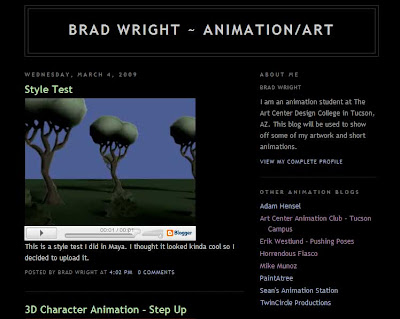
Monday, December 6, 2010
this blog and others

Sunday, March 21, 2010
More Student Work
New Mexico Symphony Guild Ball - Dara Elerath from The Art Center Design College on Vimeo. Dara is a Senior at the Art Center Design College in Albuquerque majoring in Visual Communications.
Animation instructor Aaron Barreras turned loose both sections of his AN307 Motion Graphics class on this project allowing each of his students to create a version of this promotion for the New Mexico Symphony Guild. With 21 individual commercials to choose from thanks to all of our talented students, the New Mexico Symphony Guild Ball organizers had a difficult time choosing a single spot to run. So much so, they ended up choosing 2 spots to run. The winning students, Dara Elerath and Ryan Salway, will have their commercials (shown above) aired on all Comcast channels in New Mexico.
There is no learning experience like that of working for real clients. The pro-bono Membership promotional project completed here in Tucson for The Loft Cinema last January was a very eye-opening and inspiring experience for the students involved. Another project for The Loft here in Tucson is underway, as well as other community-based creative projects moving forward in Albuqueruqe, NM. Reaching out to the community has been a real boon for our students, and I can't count the number of blessings that have rolled back to us in response.
Wednesday, February 10, 2010
Student Work
Loft Membership Pro-bono from The Art Center Design College on Vimeo.
This is a 1-minute promotional animation encouraging patrons to join as members of the non-profit, community art-house theater called The Loft Cinema located in Tucson, AZ. This animation was created by Junior level students enrolled at The Art Center Design College. The work was completed as pro-bono. The mission of The Art Center Design College includes a priority to be a contributing member of the surrounding community and to model this mission for the growth and development of our students as citizens. The Loft Cinema is a 501(c)(3) nonprofit organization. The client is very pleased with what was created and is happily screening this membership promotional animation in front of every feature film.
The group of students who created this are now working on a second pro-bono project for The Loft Cinema, and the client is excited for how this new project will turn out. You can watch the progress of this project as well as the personal films these students create as they blog their production process. Credits for the Loft membership include: Charles Rorke, Eva Alcazar, Auston Klezcka, Brenda Rodriguez, Benjamin Gray, and Arman Jornoush. This team of artists has grown stronger by one, being joined by Christian Suarez, and once again are directed by comic artist, writer and Art Center Animation Instructor Max Cannon.
We are happily anticipating what the new collaborative and independent films will be developed by this talented and committed group of artists.
-e
Tuesday, September 22, 2009
Essential Acting Principles

- Conflict with Self
- Conflict with a Situation or Environment
- Conflict with Another Character


Monday, March 16, 2009
Blogs of note

Just want to point out a few blogs. I found out about the blog illustrated above thanks to referral clicks registered at sitemeter. A character animator located in Savannah, GA named John Paul Rhinemiller has started a very nice blog for animators who are interested in valuable resources. I've already found some interesting links that are new to me. Anyone who knows me knows that I am the collector of links to online resources. He has very nicely pointed me in the right direction regarding his blog which I unfortunately credited to someone else by mistake. So, thanks JP.
After I responded to JP's recent request for animated shorts worth knowing about he was nice enough to post Sean Coleman's Scratch, Sean's portfolio website, and Sean's blog. Sean graduated from The Art Center Design College, where I teach and chair the Animation Department at our Tucson, AZ campus. He participated in FJORG! 2008 on a team with two animators from Animation Mentor, sharing a second place position with one other team. These days Sean animates for Insomniac Games in Burbank, CA. Sean's film Scratch has made the festival circuit winning awards including a Gold ADDY award for Student Best of Show here in Tucson and has moved on to the regional ADDY Awards with the collaborative Siggy intro completed with Mike Munoz and Brad Wright.
Mike Munoz is another recent graduate from The Art Center and is an extremely multi-faceted artist with numerous strengths. He has been working at a modeler for a colleague of mine named Gav Gnatovich, who teaches here at The Art Center. In addition to his 3D modeling abilities Mike is an highly skilled character setup artist. He came to The Art Center with an engineering background, developed a strong art and animation portfolio, and then fused the two areas of art and engineering together. Since graduation Mike created a very sophisticated and almost entirely automated character setup toolkit for Maya using Python. Check out Mike's blog to get a hint of the number and quality of tools he has created so far.
Brad Wright worked with Sean and Mike on the animated Siggy intro we currently use for The Art Center's animation demo reel. Brad has focused his portfolio on organic modeling while continuing to develop his Character Animation skills in 2D and 3D. He is still taking classes but already has professional modeling and animation work to his credit.
Last but not least is the Art Center Animation Club blog just created by Auston Kleczka and Eva Alcazar, two animation students here in Tucson who have taken the reigns of this club and seem to have a very clear and positive goal of creating a community of animators supporting other animators... not unlike what JP Rhinemiller is doing. I think this completes a nice circle for this post.



